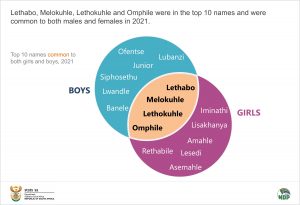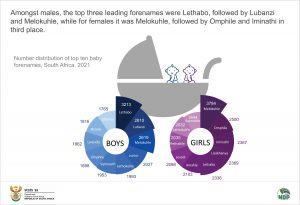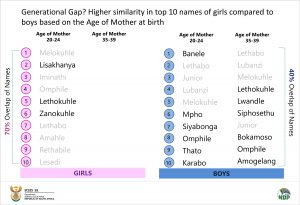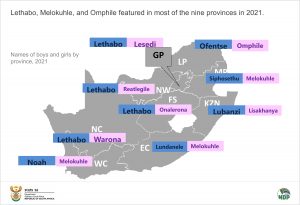Almost 1 million births in 2021 and the most popular baby name is ….
According to the Recorded Live Births, 2021 report released by Statistics South Africa, almost 1 million births occurred in 2021 and the most popular baby names were Lethabo and Melokuhle for boys and girls respectively.
Melokuhle, Lethabo and Lethokuhle were the most popular names amongst both baby girls and boys in South Africa in 2021.
Naming of a new-born child plays a very important role in most cultures around the world. For instance, African baby names are given for reason, relevance and purpose. Similarly, South Africa is a country with a variety of cultures and religions and this has a profound influence on baby naming. From the day or time a baby is born to the circumstances surrounding the birth, several factors influence the names parents choose for their children. For example, Lethabo signifies joy and happiness, Melokuhle represents good things, Lubanzi signifies acceptance and Iminathi signifies standing with us (God is).
Amongst males, the top three leading forenames were Lethabo, followed by Lubanzi and Melokuhle. The leading forenames for females were Melokuhle, followed by Omphile and Iminathi in third place. Melokuhle, Lethabo and Lethokuhle appeared on both males and females top ten list. Melokuhle ranked first amongst females while it ranked third amongst males. In general, the popular baby forenames for males and females reflect positive hopes for the child, express beliefs and are inspired by positive connotations of both love and acceptance.
For both sexes, Dlamini was the most common baby surname in 2021, followed by Nkosi and Ndlovu. Nine of the surnames were from the Nguni clans namely isiZulu, isiXhosa, isiNdebele and siSwati. Mokoena which featured as the sixth most popular surname was the only non-Nguni surname.
Information regarding the mothers age at the birth of child is crucial for planning, monitoring and evaluation of programmes focusing on maternal and child health, social welfare, access to family planning, curbing teenage pregnancies and safe motherhood initiatives (United Nations, 2015). When considering the age of the mother at the birth of the child, there appears to be a similarity in top 10 names of girls compared to boys.
Of note was the increasing number of teenage mothers in 2021. A total of 45 257 births were from mothers aged 17 years and younger and of these, 42 were births from mothers between the ages of 11 and 12.
The provincial picture shows a similar trend where the names Lethabo, Melokuhle, and Omphile featured in most of the nine provinces in 2021.
A total of 1 087 526 births were registered in 2021. Of these, 949 757 (87,3%) registrations for births that occurred in 2021, while 137 769 (12,7%) were late registrations for births that occurred in previous years. This indicates a 3,5% decrease in current registrations from levels observed prior the COVID-19 pandemic.
Negative impact of the COVID-19 pandemic on service delivery, and associated restrictions on movements are still evident in the patterns observed in the 2021 birth registrations data. The reversal of gains made in timely registration of births (registration within 30 days) and increase in late registrations in the last two years are evident from the 2021 registrations data. The number of births within 30 days declined by 15,5% in 2019-2020, with an unusually large increase observed in 2020-2021 (14%), indicating a possible recovery from the COVID-19 pandemic period.
Generally, birth registrations remain higher in the most populated provinces in South Africa. The highest proportion of births were registered in Gauteng (21,4%), followed by KwaZulu-Natal (20,4%). Provinces with lower birth registrations in 2021 were Northern Cape at 2,7% and Free State at 5,0%.. The patterns are similar to those recorded for 2020.
This report provides information on recorded live births for births that occurred in 2021 as well as information on late birth registrations from 1998 to 2020. It also shows trends and patterns in birth occurrences and registrations over a period of 23 years.
For more information, download the full report here.





